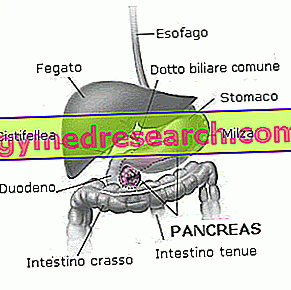What is the Pancreas?
The pancreas is a voluminous, long and flat gland, situated transversally in the upper and rear part of the abdominal cavity.
In young subjects it reaches a weight of about 80-100 grams, which tends to reduce with advancing age; the overall length is around 15 centimeters.
Anatomy

The head represents its thickest and thickest part and makes contact with the duodenal loop.
The body, slightly oblique from bottom to top, represents the intermediate segment and is placed frontally with respect to the aorta and the vena cava.
Finally, the tail of the pancreas is related to the hilum of the spleen and represents the thin section with which this glandular organ ends.

Pancreas functions
The pancreas has a dual function, endocrine on one side and exocrine on the other. The first term refers to its ability to secrete the hormones it synthesizes in the bloodstream, while the exocrine function consists in the production of digestive enzymes to be introduced into the digestive tract.
Exocrine Pancreas
Pancreatic acini represent the anatomical areas responsible for exocrine secretion; inside we find particular cells, called acinar ones, which produce digestive enzymes in an inactive form, to then pour them, under the influence of certain physiological stimuli, into the duodenum.
Having arrived here, after having crossed a tree of converging canals in the main pancreatic ducts (duct of Wirsung) and accessory pancreatic duct (Santorini duct), these enzymes are activated by other proteins and can finally carry out their chemical action.
The various digestive enzymes produced by the pancreas can be classified, according to their activity, into different categories, which on the whole give rise to the so-called pancreatic juice :
- AMYLASES: they transform food starch into a mixture of simple sugars (disaccharides, maltose, glucose) which will then be absorbed at the level of the intestinal mucosa.
- CHIMOTRIPSINA, TRIPSINA, CARBOSSIPEPTIDASI: hydrolyze the peptide bonds present inside the protein structures, fragmenting them into the single amino acids that compose them.
- LIPASES: assisted by bile and colipase enzymes, they catalyze the hydrolysis of triglycerides by breaking them down into their most basic components (glycerol and fatty acids).
- RIBONUCLEASI and DESOSSIRIBONUCLEASI: they demolish, respectively, ribonucleic acids (RNA) and deoxyribonucleic acids (DNA).
In addition to these digestive enzymes, the pancreatic juice is rich in bicarbonate ions, which are fundamental for buffering the acidity of the chyme coming from the stomach and guaranteeing a slightly alkaline environment favorable to the activity of the digestive enzymes themselves.
Endocrine Pancreas
The endocrine secretion of the pancreas is performed by the islands of Langerhans, which play a leading role in controlling the metabolism of sugars, fats and proteins.
The endocrine portion of the pancreas produces two very important hormones to regulate the level of glucose in the blood:
- insulin : it is produced by beta cells that represent, quantitatively, about 3/4 of the islands of Langehrans;
- glucagon : it is produced by alpha cells (20% of the total mass of the Langehrans islets).
These pancreatic hormones are associated with a third, called somatostatin, and a fourth, pancreatic polypepetide.
As mentioned in the introductory part, the hormones produced by the endocrine portion of the pancreas are released directly into the blood capillaries surrounding the islets.
To learn more about the individual functions of these hormones, click on the link of your interest:
- insulin,
- glucagon,
- somatostatin,
- carbohydrate metabolism.

Pancreatic diseases
Among the diseases that can affect the pancreas or that depend on its malfunction, we recall:



